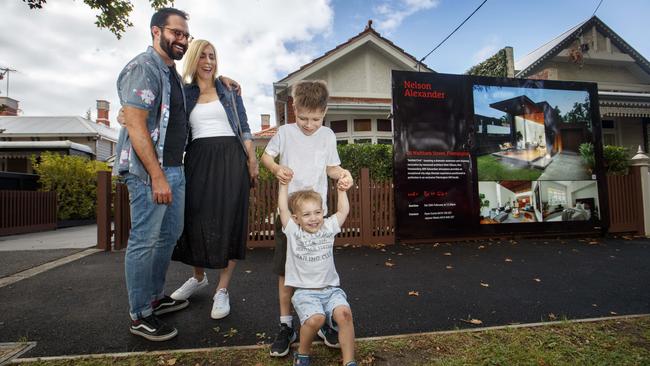Housing market being driven by ‘fear of missing out’
The housing market is again taking flight, with Sydney and Melbourne showing signs of a longer-term resurgence.

The housing market is again taking flight, with Sydney and Melbourne showing signs of a longer-term resurgence, according to CoreLogic Asia Pacific head of research Tim Lawless.
The latest numbers from the research house, headlined by a 2.1 per cent rise in prices nationally, have seen a shift from smaller capitals driving the strongest capital gains to the two largest cities being back on the rise.
While “fear of missing out” is driving auction clearance rates ever higher, Mr Lawless says the result has surprising elements as both cities are already highly unaffordable, and took a bigger hit from immigration falling away.
“The reality is both of those markets are probably playing catch-up,” he says, noting they had a weak period as the COVID pandemic broke out.
Values in both cities still sit below earlier peaks, with Sydney values more than 1 per cent lower than in mid-2017.
But this could change as home price rises grind on, meaning affordability challenges will resurface while wages remain flat and first-time home buyers become less active in the market.
Mr Lawless expects momentum to continue this year and probably into 2022, as the housing market is being driven by record low mortgage rates that we are not expected to shift, but he says this may change as the economy picks up.
If interest rates push higher or rises are expected ahead of 2024 this would “probably start to play through into the marketplace”, Mr Lawless said. “But I think the key factor that is going to slow markets progressively is basically housing affordability.”
As first-home buyers become less active, due to affordability challenges, the market may also run into challenges from the winding down of fiscal support and first-home buyer stamp duty relief rolling off.
But overall Mr Lawless said demand for homes continued to outweigh the supply coming onto the market, which should keep momentum up as consumer sentiment was also rising.
AMP Capital head of investment strategy and chief economist Shane Oliver dubbed the 2.5 per cent rise in Sydney dwelling prices “very strong”, saying prices were up 2.8 per cent on a year ago before the pandemic hit. Melbourne prices also rose 2.1 per cent, resulting in four months of gains in the wake of lockdowns, but they are down 1.3 per cent on a year ago, reflecting a hit during the pandemic.
Prices in other cities were all up strongly, led by Hobart with prices up 2.5 per cent, followed by Canberra up 1.9 per cent, Brisbane and Perth both up 1.5 per cent, Adelaide up 0.8 per cent and Darwin up 0.7 per cent.
In a sign of the strength that had already built up outside the two major capitals, prices in Hobart, Canberra, Brisbane and Adelaide are already at record highs.
Those cities are less vulnerable to financial stresses caused by the pandemic driven economic downturn, took a smaller hit from lower immigration and are also benefiting from people shifting for lifestyle reasons.
“The combination of reopening unleashing pent-up demand, government incentives, the removal of responsible lending obligations, record low mortgage rates, the desire to “escape from the city” and relatively low property listings are all helping to push prices higher, with an element of FOMO (or the “fear of missing out”) creeping in too,” Mr Oliver said.
“This is after bank payment holidays and government income support measures averted a sharp fall in prices that would otherwise have followed from the pandemic recession. The combination has more than offset the impact of weak inner city rental markets and the hit to immigration and has brought forward demand from first-home buyers and owner-occupiers, with investors now starting to jump in too,” he said.
Mr Oliver says Australian home prices are likely to rise another 5 to 10 per cent this year and next, being boosted by record low mortgage rates, government home buyer incentives and the recovery in the jobs market.
But he said the stop to immigration and weak rental markets was likely to constrain price gains in inner city areas and units in Melbourne and Sydney. Outer suburbs, houses, smaller cities and regional areas would see relatively stronger gains in 2021.
He warned the acceleration in home prices was likely to be starting to concern the Reserve Bank but with average prices only just exceeding their 2017 high, growth in housing debt remaining relatively subdued at 3.6 per cent year on year and little evidence of a significant deterioration in lending standard, Mr Oliver said the central bank and APRA were unlikely to reach for the macro prudential lever just yet.
CommSec senior economist Ryan Felsman said home prices could lift further. Commonwealth Bank economists expect national home prices to lift by about 8 per cent in 2021, despite lower population growth and rising supply of detached houses possibly slowing price momentum.
Mr Felsman noted that despite the more recent city surge, regional Australian housing markets — benefiting from a lifestyle switch, remote working, internal migration, closed borders and better affordability — were locking in massive price gains during the pandemic.
Regional home prices surged 9.4 per cent in the year to February, the strongest annual growth rate in 16.5 years. Smaller capital cities are leading home price gains with Sydney and Melbourne still lagging on a longer scale.
Dwelling prices in Sydney are still 1.1 per cent below the July 2017 peak and Melbourne home prices are 1.7 per cent below the March 2020 peak.
Mr Felsman said Perth and Darwin had a lot of catching up to do. Notably, Perth home prices are 17.4 per cent below the June 2014 peak and Darwin 23.4 per cent below the April 2014 peak.








To join the conversation, please log in. Don't have an account? Register
Join the conversation, you are commenting as Logout